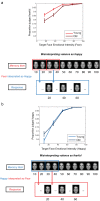Changing interpretations of emotional expressions in working memory with aging
- PMID: 30321038
- PMCID: PMC6764502
- DOI: 10.1037/emo0000481
Changing interpretations of emotional expressions in working memory with aging
Erratum in
-
"Changing interpretations of emotional expressions in working memory with aging": Correction to Mok et al. (2018).Emotion. 2019 Sep;19(6):1092. doi: 10.1037/emo0000604. Epub 2019 Jun 24. Emotion. 2019. PMID: 31233314 Free PMC article.
Abstract
[Correction Notice: An Erratum for this article was reported online in Emotion on Jun 24 2019 (see record 2019-34942-001). In the article, the plots for Figure 3a shifted incorrectly to the right. The error bars should be centered on 10, 30, 50, 70, and 90. The corrected figure is present in the erratum.] Working memory (WM) shows significant decline with age. It is interesting to note that some research has suggested age-related impairments can be reduced in tasks that involve emotion-laden stimuli. However, only a few studies have explored how WM for emotional material changes in aging. Here we developed a novel experimental task to compare and contrast how emotional material is represented in older versus younger adults. The task enabled us to separate overall WM accuracy from emotional biases in the content of affective representations in WM. We found that, in addition to overall decline in WM performance, older adults showed a systematic positivity bias in representing information in WM relative to younger adults (positivity effect). They remembered fearful faces as being less fearful than younger adults and interpreted ambiguous facial expressions more positively. The findings show that aging brings a type of positivity bias when picking up affective information for guiding future behavior. (PsycINFO Database Record (c) 2019 APA, all rights reserved).
Figures



References
-
- Baddeley A. D., & Hitch G. (1974). Working memory. Psychology of Learning and Motivation, 8, 47–89. 10.1016/S0079-7421(08)60452-1 - DOI
-
- Bradley B. P., Mogg K., & Millar N. H. (2000). Covert and overt orienting of attention to emotional faces in anxiety. Cognition and Emotion, 14, 789–808. 10.1080/02699930050156636 - DOI
MeSH terms
Grants and funding
LinkOut - more resources
Full Text Sources
Miscellaneous

